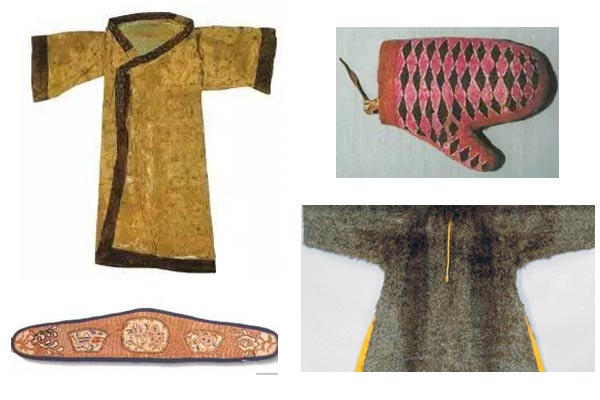
From above left, clockwise: An ancient windcoat, an embroidery diamond-pattern glove from Northern dynasties, a fox-fur overcoat worn by Emperor Qianlong of the Qing Dynasty, a head wear.
Although it is chilly outside in winter, we have heating systems to keep us warm indoors in most parts of North China, and in South China, they at least have air conditioners or electric radiators. But how did ancient people in China keep warm without these modern appliances?
Temperature adjustable room daubed with pepper mash
During the Qin (221-206 BC) and Han (206 BC-220) dynasties, temperature adjustable rooms emerged in royal families. Royal court had larger and more advanced rooms, called the "temperature adjustable hall". Imperial palaces such as Changle Palace and Weiyang Palace in Western Han Dynasty (206 BC-AD 24) had temperature adjustable halls. Changle Palace was originally used as the government's "office building" and "president suite" for Liu Bang (the first emperor of the Han Dynasty), and then was used as the residence of empress dowagers. Changle Palace not only had heating rooms for winter, but also rooms for cooling down in summer.
These halls were also a good place to store books as a comfortable temperature could help preserve books and provide a better environment for reading.
It is said that the "temperature adjustable hall" was built with pepper mash daubed on the wall, embroidery tapestries hung on the wall and a thick blanket paved on the ground. Windshield screens and wild goose feather-made curtains were also used to keep cool air outside.
Ground heating system
Kitchen range made with sun dried mud bricks were also found in Han Dynasty ruins which was equipped with discharge flue. In addition, a fireplace was found beside the wash bath at the ruins of Xianyang Palace dating from the Qin Dynasty.
During the Ming (1368-1644) and Qing (1644-1912)dynasties, a ground heating system was used indoors, which was built by concreting circular flue underground. The charcoal fire smoke would flow through channels to the whole room and raise the temperature indoors. The ground heating system enabled the room heat up evenly and mildly. As the fiery pit and smoke jack was set outdoors, the heating method was safe, clean and practical.
The ground heating system wasn't invented by Ming and Qing dynasty people. It emerged as early as Wei and Jin dynasties (AD 220-420). The historical record shows that the northeast part of China had used fire pits to keep warm during that time, which functioned similarly as a ground heating system.
Different censers used as warmers and coal subsidies for officials
China is where coal was first discovered and used to cook and keep warm. Tang Dynasty (AD 618-907) imperial families were recorded to have used imported coal. Most families used manmade charcoal while wealthy families had more requirements on coal. The residence of Yang Guozhong, who was the prime minister of Tang Dynasty Emperor Xuanzong, used special coal in winter. The carbon dust was kneaded into a double-phoenix shape using honey, and fine sandalwood was paved at the bottom of the stove while burning, which was very clean.
Censer was often used for heat during ancient times, which was made of two parts: the bottom was a basin and the top was a hollow cover made with flower patterns. Putting coal inside, censers were used as warmers and made into different sizes for hands and feet. The censers were usually copper-made in the royal court and clay or iron-made among folk people.
Tangpozi, a pumpkin-shaped bronze kettle full of boiling water was also quite commonly used to keep warm in ancient times. It could be put under a quilt, similar to today's hot-water bottle.
All these warmers require fuel, and fuel occupied a large part of expenses in winter, so the court gave coal subsidies to officials. During the Song Dynasty (960-1279), the subsidy was paid by giving out coal, and the Ming Dynasty gave out cash instead.
Ancient royal court had a special team, called "coal soldiers", to solve the heating supply issue, taking charge of the official use of coal.
Winter clothing made of special materials kept people warm
Song Dynasty poet Su Shi had mentioned a kind of cloth resembling a wind coat similar to today's coats in his poem. With the weather getting colder, silk floss or cotton wool was put inside clothes to make them warmer but was still light.
According to writer Shen Congwen's book on the study of Chinese ancient clothes, wool textile was used to make clothes since the Eastern Jin Dynasty (AD 317-420). Animal fur was also used to make winter clothing, such as squirrel skin and raw fox skin.
Among cultural relics unearthed from the Mawangdui Han Dynasty Tomb, different kinds of gloves were found. Gloves from the Northern dynasties (386-581) and Ming Dynasty were also unearthed. Folk women in the Ming Dynasty used to wear "patou" on their heads to keep warm. Han Dynasty men used to wear silk towels around their heads, which was filled with silk floss inside to keep warm. Yuan, Ming and Qing dynasty people also wore similar headwear.
Ancient people were smart in adapting to the environment and had solutions for the chilly winter. In addition to all their equipment, they also drank wine to keep warm, just like modern people in North China.